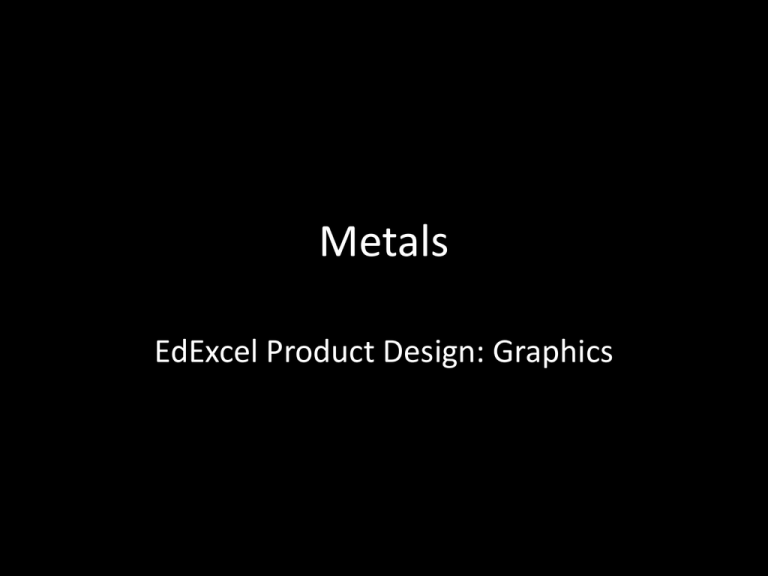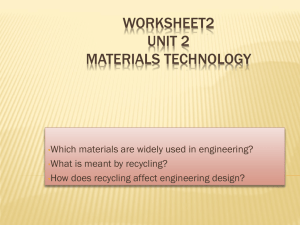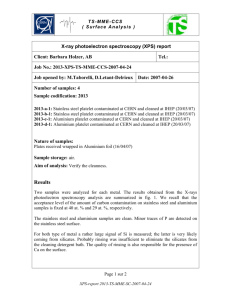Metals - DT Help
advertisement

Metals EdExcel Product Design: Graphics Metals • Ferrous – Steel • Non-ferrous – Aluminium – Tin • Alloys – Stainless steel – duralumin • Aesthetic • Functional & mechanical properties • Application • Advantages • Disadvantages • For graphic products & commercial packaging Properties • Ductility (being ductile) – is a solid material's ability to deform under tensile (pulling/tension) stress; this is often characterized by the material's ability to be stretched into a wire. • Malleability – is a material's ability to deform under compressive stress; this is often characterized by the material's ability to form a thin sheet by hammering or rolling. • Hardness – is a measure of how resistant solid matter is to various kinds of permanent shape change when a force is applied. • Corrosion resistance – Is the materials ability to not corrode (or rust). Some metals are more intrinsically resistant to corrosion than others. Micro-structure of metals Metals usually have one or two loose electrons in their outer electron shell and therefore they are likely to become easily detached, it is this movement of electrons which accounts for metals high electrical and thermal conductivity. This ability for movement also leads metals to have ductile and malleable properties. All metals are solid at room temperature (with the exception of mercury). When in a solid state the atoms energy is reduced and they arrange themselves in a regular lattice structure in the form of small seed crystals or grains, there are 3 possible lattice structures; •Closed-packed hexagonal (CPH) •Face-centred cubic (FCC) •Body-centred cubic (BCC) CPH FCC BCC Structure Properties Examples CPH Weak, poor strength to weight ratio. Zinc, magnesium FCC Ductile, good electrical conductor. BCC Hard, tough. Gold, copper, silver, aluminium, tin Chromium, steel. Micro-structure of iron: Iron changes from BCC lattice to FCC lattice at 9100C and above 14000C it changes back again. In the FCC form it absorbs carbon which essential for steel making. Steel • Dull grey in colour (brown with corrosion) • Steel is an alloy of iron and other elements, including carbon. • Alloys with a higher than 2.1% carbon are known as cast iron. Because they are not malleable even when hot, they can be worked only by casting (pouring metal into a mould) • Magnetic • Melting point for steel 800-1500 degrees C. • Usually the least expensive metal • Corodes easily • Hardening & tempering can be used • Key metals: HSS, mild steel, cast iron, carbon steel Aluminium • Appearance ranging from silvery to dull gray • Aluminium is the most abundant metal, in the Earth's crust. • Relatively soft, durable, lightweight, ductile and malleable metal. • Does not corrode • It is non-magnetic. • Melting point: 660°C • Comes from bauxite in its raw form. • Once extracted electrolysis is used for processing Bauxite is difficult to break down and therefore electrolysis is needed rather than melting so that it can be processed (this process requires a great deal of electrical expenditure). The bauxite (red-brown solid) - aluminium oxide mixed with impurities - is extracted from the earth. It is the most used non-ferrous metal: Automobiles, aircraft, trucks, railway cars, marine vessels, bicycles, packaging (cans, foil, etc.), cooking utensils, watches, street lighting poles, sailing ship masts, walking poles, outer shells of consumer electronics, also cases for equipment e.g. photographic equipment. Tin • • • • Is malleable & ductile Silvery-white metal. Tin melts at a low temperature of about 232 °C Tin resists corrosion from water but can be attacked by acids and alkalis. Tin can be highly polished and is used as a protective coat for other metals.[4] In this case the formation of a protective oxide layer is used to prevent further oxidation. • Mainly mined in china • About half of tin produced is used in solder. The rest is divided between tin plating, tin chemicals, brass and bronze, and niche uses Stainless Steel • Stainless steel does not readily corrode, rust or stain with water as ordinary steel does. • Magnetic • Poor conductor of electricity • Melting point: 1510°C • Stainless steels are iron alloys with a minimum of 10.5% chromium. Other alloying elements are added to enhance their structure and properties such as formability, strength and cryogenic toughness. These include metals such as: • Nickel • Titanium • Copper Duralumin • Aluminium Alloy - The main alloying constituents are copper, manganese, and magnesium. • Strong, hard, lightweight alloy of aluminum, widely used in aircraft construction, • After heat treatment and aging, these alloys are comparable to soft steel in strength. • Duralumin alloys are relatively soft, ductile, and workable in the normal state; they may be rolled, forged, extruded, or drawn into a variety of shapes and products. Their light weight and consequent high strength per unit weight compared with steel suit them for aircraft construction. • Melting point 650°C Questions 1. Explain what is meant by the term alloy? 2. Explain in detail the difference between ferrous and non-ferrous metals. 3. Define the terms ductile, malleable and corrosion resistant. 4. Suggest a use for: Mild Steel, stainless steel, Aluminium, Copper, Brass & Lead Task • Log onto the computers • Create a table: Wood Aesthetics Functional & mechanical properties Advantages Disadvantages Steel Aluminium Tin Stainless steel Duralumin For aesthetics get an image of the metal and write a brief descrition. For properties add things like lightweight or malleable etc Then put some advantages and disadvantages for each Print off





